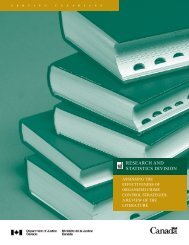National Threat Assessment 2008. Organised Crime - Politie
National Threat Assessment 2008. Organised Crime - Politie
National Threat Assessment 2008. Organised Crime - Politie
Create successful ePaper yourself
Turn your PDF publications into a flip-book with our unique Google optimized e-Paper software.
Scale<br />
For years the Netherlands has been in the top 10 of the least corrupt countries<br />
in the world. This Corruption Perceptions Index is not based on quantitative<br />
data, but on the perception of key figures in the business community and the<br />
government. Obtaining reliable figures about the scale of corruption is extremely<br />
difficult, which was also confirmed in the present research. As with many<br />
criminal phenomena, there is a dark number, as a result of which the actual scale<br />
of the activities remains unknown. It turns out to be difficult to prove any<br />
suspicion of corruption. Many of the cases end in dismissals or acquittals.<br />
Since the first NTA, however, some progress has been made in the records<br />
that are kept. Since 2004 a database has been maintained to record integrity<br />
breaches within the police force: Registratie Interne Onderzoeken (RIO). The<br />
2006 report indicates a total of 1393 investigations, in which 1495 people and<br />
1514 offences were involved. Criminal offences were identified in 180 cases and<br />
dereliction of duty in 507 cases. A total of 110 people were dismissed, 64 people<br />
were conditionally dismissed and 42 people resigned. The RIO database does not<br />
include a separate record of cases connected to organised crime, but there are<br />
a number of categories that could indicate the involvement of organised crime.<br />
One major category is ‘misuse of office’. This applied to 258 of the 1514<br />
offences in 2006 (around 17%). In 53 cases information was leaked to criminals<br />
and 10 cases of bribery were recorded. Bribery is difficult to prove. Out of the<br />
481 cases of integrity breaches ‘relating to a legal status’, 61 were cases of<br />
‘undesirable contacts’.<br />
A total of 345 cases were reported to the <strong>National</strong> Police Internal Investigations<br />
Department in 2006, 120 of which were taken up. There were 46 corruption<br />
cases. This number is increasing: there were 14 corruption cases in 2005.<br />
It should be noted, however, that this difference is mainly due to a different<br />
recording method, in addition to increased capacity and a different definition.<br />
There is a consensus that more corruption would be discovered if there were<br />
greater investment in investigating corruption. People often have (vague)<br />
suspicions of ‘leaks’, for example, with regard to failed raids and attempted<br />
arrests, whereby the suggestion is that the suspects were aware in advance<br />
and had therefore been tipped off. These suspicions, which are often not<br />
investigated, could be dismissed as rationalisations by police officers trying to<br />
explain setbacks. Sometimes, however, things really do occur in investigations<br />
that can only be explained by leaks, e.g. if documents from an investigation<br />
are found in the possession of criminals, although the trial has not started<br />
yet. The line of reasoning is that these documents could not have come<br />
from the lawyer, so they must have come from the police.<br />
182 <strong>National</strong> <strong>Threat</strong> <strong>Assessment</strong> 2008 – <strong>Organised</strong> crime








